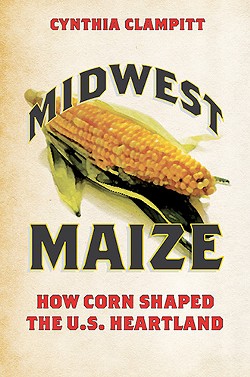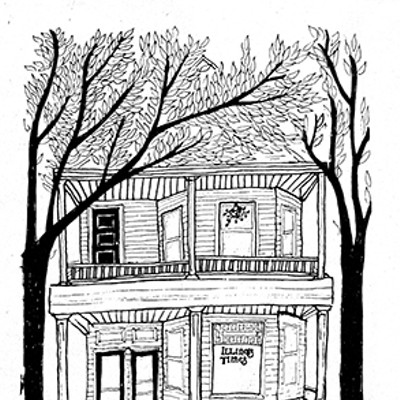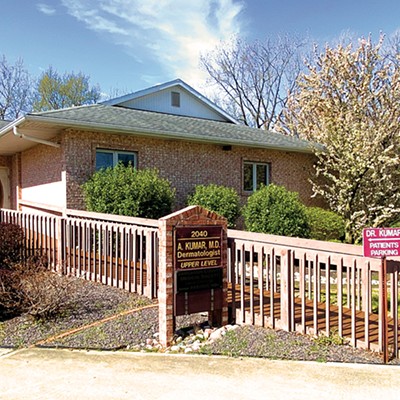Where corn is god
A new book offers not quite everything you wanted to know about corn
[
{
"name": "Air - MedRect Combo - Inline Content 1",
"component": "11490391",
"insertPoint": "3",
"requiredCountToDisplay": "1",
"parentWrapperClass": "fdn-ads-inline-content-block"
},{
"name": "Air - MedRect Combo - Inline Content 2",
"component": "11490392",
"insertPoint": "7",
"requiredCountToDisplay": "5",
"parentWrapperClass": "fdn-ads-inline-content-block"
},{
"name": "Air - MedRect Combo - Inline Content 3",
"component": "11490393",
"insertPoint": "12",
"requiredCountToDisplay": "9",
"parentWrapperClass": "fdn-ads-inline-content-block"
}
]
I grew up within a block of a corn field on the east end of Springfield. Nearly every weekend of those years we’d visit the relatives on their farm outside Beardstown; over the potholes and through the corn, to grandmother’s house we’d go, with me entranced by the corn rows, like the spokes of a spinning wheel. But while I knew how a combine harvester worked, sort of, because I’d seen them on TV, everything else about corn was as mysterious to me as the Tokyo underground or the tribal history of the Pashtun. In this I was a true Downstater. We can tell a corn plant from a telephone pole, but that’s about it.
Those who find this burden of ignorance heavy will find relief in a new book, Midwest Maize by Cynthia Clampitt, published last April by the University of Illinois Press. The shelf of good books about corn is not a long one, but it does contain John C. Hudson’s Making the Corn Belt – essential to understanding the region’s history -- and Betty Fussell’s The Story of Corn. Unlike them, Clampitt’s book is not a history. Rather it is a compendium of facts and anecdotes, snippets of history and even some recipes. The reader will learn how the grain is grown, its origins and improvements, how it’s shipped and sold, which products you can make from it and which dishes you can cook with it and some of the many controversies that attend it, from trade to genetic modification. Read it attentively, and you will be able to astound your driving companions on your next trip to a Cards game. It would make a welcome wedding present, I’m sure, and what new graduate would not be grateful for a copy to read while sitting at the unemployment office?
Corn certainly shaped mid-Illinois but, as Clampitt reminds us, mid-Illinois shaped the corn industry too. The region was the site of A.E. Staley’s corn processing plant in Decatur, the biggest in the world when it opened in 1909. It was home to hybridizers like McLean County’s Funk Bros. Seeds, a dozen inventors who made improvements to corn planters and harvesting machines and to the U of I, which was to the corn agro-industry what Stanford was to computers.
The notion that corn built the Midwest is defensible, but it is absurd to claim, as some among the corn lobby do, that corn sustains the Midwest. Corn dominates the landscape hereabouts, yet it is in social and economic terms a negligible presence. The Illinois Department of Agriculture tells us proudly that the marketing of the state’s agricultural commodities in 2014 generated more than $19 billion annually, of which corn accounts for 54 percent, or a bit more than $10 billion. That’s not a lot of money in a state whose gross state product is $746 billion; corn receipts accounted for 1.4 percent of the state’s output that year.
My disdain for today’s agro-industrial complex burns with a hard, gem-like flame but the intertwined histories of corn and Illinois fascinate me nonetheless. Corn whiskey was one of the first value-added products of Illinois ag. It is not too fanciful to say that Illinois thus owes its Dawn Clark Netsches and Hillary Clintons to corn; whiskey begat drunk husbands, drunk husbands begat angry wives and mothers, who, being disenfranchised and thus unable to assert their will on the politicians, begat angry suffragettes, who begat the vote, in 1919.
And what has corn done for us lately?” you ask. The question is left largely unexamined by Clampitt. The book, we are told, is about “how corn shaped the U.S. heartland” but that is not quite accurate. A good field in mid-illinois these days is likely to have more than 30,000 corn plants per acre. Such intense corn production is responsible for increased fertilizer use (and consequent water pollution), increased production of greenhouse gases and consumption of such massive amounts of water that corn might be changing mid-Illinois weather. (See my “It’s not the heat, it’s the corn,” July 21, 2011.) But the author’s index does not include the terms “dead zone, “Gulf of Mexico” or “pollution.”
Likewise, Clampitt explores maize’s role in the American diet; as noted, the book even has recipes. But corn is the least nutritious of the cereals, especially when one eats it, as Americans do by the ton, in the form of fried snacks and sugary drinks. The implications of subsidizing the production of cheap starches in a nation plagued by obesity and diabetes is by now a moral question as well as a public health crisis, but that is not explored here. Clampitt’s index does not include the words “diabetes,” “health” or “diet.” Some native Americans sacrificed living maidens to the corn god; we sacrifice our children.
Contact James Krohe Jr. at [email protected].
Those who find this burden of ignorance heavy will find relief in a new book, Midwest Maize by Cynthia Clampitt, published last April by the University of Illinois Press. The shelf of good books about corn is not a long one, but it does contain John C. Hudson’s Making the Corn Belt – essential to understanding the region’s history -- and Betty Fussell’s The Story of Corn. Unlike them, Clampitt’s book is not a history. Rather it is a compendium of facts and anecdotes, snippets of history and even some recipes. The reader will learn how the grain is grown, its origins and improvements, how it’s shipped and sold, which products you can make from it and which dishes you can cook with it and some of the many controversies that attend it, from trade to genetic modification. Read it attentively, and you will be able to astound your driving companions on your next trip to a Cards game. It would make a welcome wedding present, I’m sure, and what new graduate would not be grateful for a copy to read while sitting at the unemployment office?
Corn certainly shaped mid-Illinois but, as Clampitt reminds us, mid-Illinois shaped the corn industry too. The region was the site of A.E. Staley’s corn processing plant in Decatur, the biggest in the world when it opened in 1909. It was home to hybridizers like McLean County’s Funk Bros. Seeds, a dozen inventors who made improvements to corn planters and harvesting machines and to the U of I, which was to the corn agro-industry what Stanford was to computers.
The notion that corn built the Midwest is defensible, but it is absurd to claim, as some among the corn lobby do, that corn sustains the Midwest. Corn dominates the landscape hereabouts, yet it is in social and economic terms a negligible presence. The Illinois Department of Agriculture tells us proudly that the marketing of the state’s agricultural commodities in 2014 generated more than $19 billion annually, of which corn accounts for 54 percent, or a bit more than $10 billion. That’s not a lot of money in a state whose gross state product is $746 billion; corn receipts accounted for 1.4 percent of the state’s output that year.
My disdain for today’s agro-industrial complex burns with a hard, gem-like flame but the intertwined histories of corn and Illinois fascinate me nonetheless. Corn whiskey was one of the first value-added products of Illinois ag. It is not too fanciful to say that Illinois thus owes its Dawn Clark Netsches and Hillary Clintons to corn; whiskey begat drunk husbands, drunk husbands begat angry wives and mothers, who, being disenfranchised and thus unable to assert their will on the politicians, begat angry suffragettes, who begat the vote, in 1919.
And what has corn done for us lately?” you ask. The question is left largely unexamined by Clampitt. The book, we are told, is about “how corn shaped the U.S. heartland” but that is not quite accurate. A good field in mid-illinois these days is likely to have more than 30,000 corn plants per acre. Such intense corn production is responsible for increased fertilizer use (and consequent water pollution), increased production of greenhouse gases and consumption of such massive amounts of water that corn might be changing mid-Illinois weather. (See my “It’s not the heat, it’s the corn,” July 21, 2011.) But the author’s index does not include the terms “dead zone, “Gulf of Mexico” or “pollution.”
Likewise, Clampitt explores maize’s role in the American diet; as noted, the book even has recipes. But corn is the least nutritious of the cereals, especially when one eats it, as Americans do by the ton, in the form of fried snacks and sugary drinks. The implications of subsidizing the production of cheap starches in a nation plagued by obesity and diabetes is by now a moral question as well as a public health crisis, but that is not explored here. Clampitt’s index does not include the words “diabetes,” “health” or “diet.” Some native Americans sacrificed living maidens to the corn god; we sacrifice our children.
Contact James Krohe Jr. at [email protected].
Illinois Times has provided readers with independent journalism for almost 50 years, from news and politics to arts and culture.
Your support will help cover the costs of editorial content published each week. Without local news organizations, we would be less informed about the issues that affect our community..
Got something to say?
Send a letter to the editor and we'll publish your feedback in print!






















